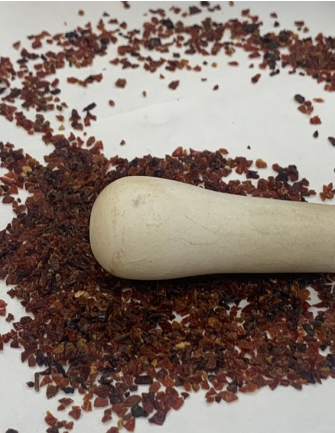
Rosehip, Rosa canina
Rosehip has gained significant recognition in the field of culinary applications due to its unique and amazing scents and flavours. The primary objectives of this research project are to conduct an analysis of Rosehip hydrosols which were obtained using microwave techniques and subsequently examined through gas chromatography-mass spectroscopy (GC-MS).

Rosehip, Rosa canina
Rosehip, logically alluded to as Rosa caninaor ‘dog rose’ and was well known for its different applications in customary medication, skincare, and culinary expressions[2][8]. Rosehip is a wild bush filling in Europe, northwest Africa, and western Asia. The products of the rosehip have been utilized in society medication for quite a while. Rosehips have prophylactic and restorative activities against the normal chilly, irresistible sicknesses, gastrointestinal problems, urinary parcel infections, nausea, and provocative illnesses [1]. In addition to its conventional usage, it has demonstrated severalpharmacological traits[7].
[1] Ilyasoğlu, Huri. "Characterization of rosehip (Rosa canina L.) seed and seed oil."International Journal of Food Properties17.7 (2014): 1591-1598.
[2]Fan, Cui, Callen Pacier, and Danik M. Martirosyan. "Rose hip (Rosa canina L): A functional food perspective."Functional Foods in Health and Disease4.12 (2014): 493-509.
[7]Emami, S. A. "Therapeutic effects of rosehip fruit types in traditional and modern medicine."Research Journal of Pharmacognosy4.Supplement (2017): 122-122.

Rosehip hydrosols were prepared using the microwave extraction method which enhanced extraction efficiency and preservation of delicate volatile compounds that may be lost during traditional distillation methods [3].100g of dried Rosehip were soaked with around 500mL of boiling hot distilled water in the microwave extraction vessel. Following an overnight soaking period, the infused herbaceous material was ready for extraction. To capture the resulting hydrosol droplets, a 300mL beaker was positioned and screwed at the center of the microwave extraction vessel. An ice cone, designed to facilitate optimal condensation, was positioned atop the vessel's lid. The microwave then runs for a duration of 9 minutes. Upon completion of each 9-minute cycle, the extraction vessels were removed from the microwave. The resulting hydrosols collected in the 200mL beaker were then transferred to a clean, dry glass bottle. A new ice cone was then placed and secured on the lid. The extraction process was repeated six times in total, with each cycle lasting 9 minutes, to ensure the comprehensive extraction of all volatile and water-soluble components from the Rosehip.
[3]Nazlić, Marija, et al. "Extraction, Composition and Comparisons–Free Volatile Compounds from Hydrosols of Nine Veronica Taxa."Horticulturae9.1 (2023): 16.

Rosehip hydrosols were then evaluated using a DB-5 MS column and GC-MS. To eliminate water and big contaminants that can clog the GC column, 1mL, 5mL and 10mL of the hydrosols sample was filtered by solid phase extraction (SPE) prior to the analysis leveraging the GC-MS equipment. During the first test run, which employed 1mL of Rosehip hydrosols works best in revealing all the components. Therefore, an additional three test run was carried out using 1mL of hydrosols to calculate the average concentrations of each component within the hydrosols

The utilization of GC-MS analysis to examine Rama Holy basil leaf hydrosols offers significant insights into their chemical makeup, facilitating the detection and characterization of volatile compounds within the hydrosols. The identification and quantification of individual constituents can be accomplished by comparing obtained mass spectra with established reference databases [4]. The chromatogram’s peaks were all recognized by comparing their mass spectra to a database. By contrasting the estimated RI values with the RI values provided for the
compound in the literature, their identities were verified and listed in Table 1.
[4]NIST Chemistry Webbook, SRD 69. Chemical Name Search. (n.d.).https://webbook.nist.gov/chemistry/name-ser/

It was then found that the restorative properties of rose hip in the suggestive treatment of osteoarthritis, stiffness,and normal virus. In additionally, there are confirmations about enemy of bacterial, hostile to malignant growth, against diabetic and against corpulence properties of this therapeutic plant[5].
[5]Selahvarzian, Amin, Abuzar Alizadeh, Peyman Amanolahi Baharvand, Omayma A. Eldahshan, and Bahram Rasoulian. "Medicinal properties of Rosa canina L."Herbal Medicines Journal (Herb Med J)(2018): 77-84
[6]Moldovan, Cadmiel, et al. "Optimization of the drying process of autumn fruits rich in antioxidants: A study focusing on rosehip (Rosa canina L.) and sea buckthorn (Elaeagnus rhamnoides (L.) A. Nelson) and their bioactive properties."Food & Function12.9 (2021): 3939-3953.
[8]Winther, Kaj, Anne Sophie Vinther Hansen, and Joan Campbell-Tofte. "Bioactive ingredients of rose hips (Rosa canina L) with special reference to antioxidative and anti-inflammatory properties: in vitro studies."Botanics: Targets and Therapy(2016): 11-23

My name is Rachael Lee, an international student from Malaysia currently in my fourth year of pursuing an Honours bachelor’s degree in chemistry at the University of Ottawa. Having the opportunity to volunteer at John L. Holmes Mass Spectrometry Facility not only allows me to develop my practical skills in analytical chemistry but also provides an invaluable platform for me to learn more about mass spectrometry and analytical chemistry. Moreover, with the aid of gas chromatography-mass spectrometry which allows examination of the chemicals contained in the hydrosols of various raw materials, I am thrilled to pursue analyzing additional plant samples using the methods I have acquired from this experience.
